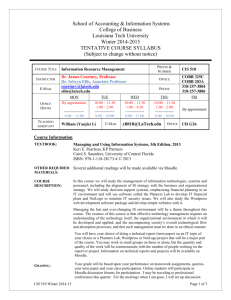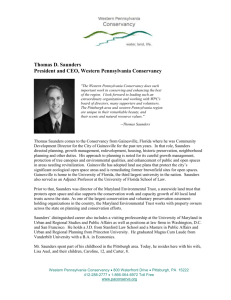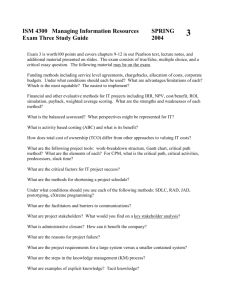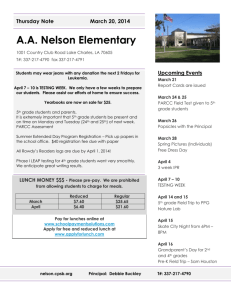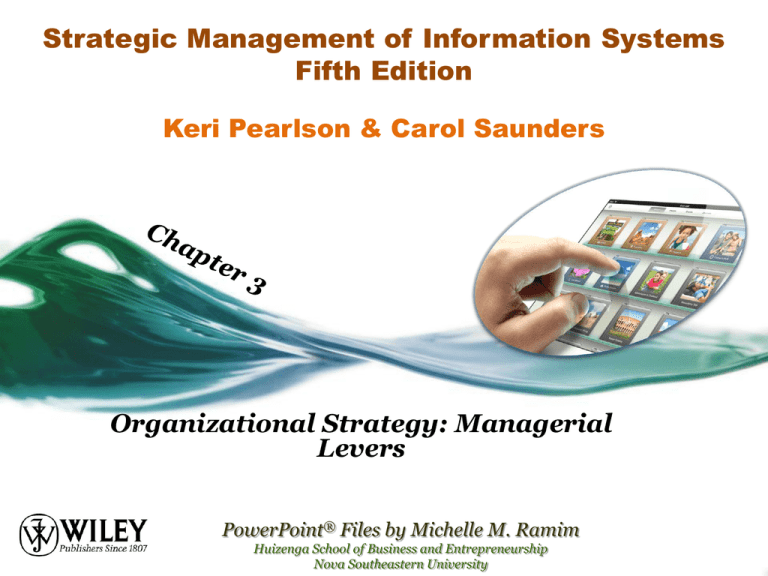
Strategic Management of Information Systems
Fifth Edition
Keri Pearlson & Carol Saunders
Organizational Strategy: Managerial
Levers
PowerPoint® Files by Michelle M. Ramim
Huizenga School of Business and Entrepreneurship
Nova Southeastern University
Pearlson and Saunders – 5th Ed. – Chapter 3
Learning Objectives
•
Understand how the use of information technology impacts an
organization.
•
Identify the type of organizational structure that tends to be most
willing to embrace technological change and sophistication.
•
List the advantages and disadvantages of the networked organizational
structure.
•
Discuss how IT has changed the way managers monitor and evaluate
•
Define and explain the concept and importance of virtual organizations.
•
Identify the challenges that are faced by virtual teams.
3-2
Pearlson and Saunders – 5th Ed. – Chapter 3
Real World Example
•
Cognizant Technology Solutions grew fast to become a $1.4 billion
revenue company providing IT outsourcing services.
•
A quick growth required that they reinvent their organization – move
from a cost based to a relationship based structure.
•
Managers had to interact with customers and developers in different
locations.
•
A tremendous strain was put on managers because they had to work day
and night.
•
Some of the units adopted a matrix structure sharing managerial
responsibilities.
3-3
Pearlson and Saunders – 5th Ed. – Chapter 3
Real World Example - (Cont.)
•
Tata Consultancy Services (TCS), the largest outsourcing company and
software exporter in India, chose a different organization structure
designed to focus on customers and boost revenue growth.
•
Added a new layer of leaders to oversee the businesses and free up the
CEO’s time to work on strategy.
•
Different organizational structures reflect different
organizational strategies that are used by organizations to
implement their business strategies and accomplish organizational
goals.
3-4
Pearlson and Saunders – 5th Ed. – Chapter 3
Organizational Strategy
•
Includes the organization’s design, as well as the managerial choices
that define, set up, coordinate, and control its work processes.
•
Optimized organizational design and management control systems
support optimal business processes which reflect the firm’s values and
culture.
•
Figure 3.3 summarizes complementary design variables from the
managerial levers framework.
•
Three types of managerial levers:: organizational, control,
cultural.
3-5
Figure 3.1 Organizational design variables.
Variable
Description
Pearlson and Saunders – 5th Ed. – Chapter 3
Organizational variables
Decision rights
Authority to initiate, approve, implement, and control various types of
decisions necessary to plan and run the business.
Business processes
The set of ordered tasks needed to complete key objectives of the
business.
Formal reporting
relationships
The structure set up to ensure coordination among all units within the
organization.
Informal networks
Mechanism, such as ad hoc groups, which work to coordinate and
transfer information outside the formal reporting relationships.
Control variables
Data
The information collected, stored, and used by the organization.
Planning
The processes by which future direction is established,
communicated, and implemented.
Performance
measurement
and evaluation
Incentives
The set of measures that are used to assess success in the execution
of plans and the processes by which such measures are used to
improve the quality of work.
The monetary and non-monetary devices used to motivate behavior
within an organization.
Cultural variables
Values
The set of implicit and explicit beliefs that underlie decisions made
and actions taken.
3-6
Pearlson and Saunders – 5th Ed. – Chapter 3
IS and Organizational Design
•
IS in the organizational designs:
o
Defines the flow of information throughout the organization.
o
Facilitate management control at the organizational and individual
levels.
•
•
Culture impacts IS and organizational performance.
IS in the organization’s physical structure is designed to facilitate the
communication and work processes necessary to accomplish the
organization’s goals.
•
The organization structures of Cognizant and TCS, while very different,
reflect and support the goals of each company.
3-7
Pearlson and Saunders – 5th Ed. – Chapter 3
Decision Rights
•
Who in the organization has the responsibility to initiate, supply
information, approve, implement, and control various types of
decisions.
•
Ideally the person with the most information and in the best
position should have these rights. (i.e. senior leaders).
•
Organizational design focus on making sure that decision rights
are properly allocated.
•
Zara - decision rights moved to the store managers, providing for
quicker responses to their local customer base.
3-8
Pearlson and Saunders – 5th Ed. – Chapter 3
Formal Reporting Relationships and
Organization Structures
•
Organization structure is the way of designing an organization so that
decision rights are correctly allocated.
•
The structure of reporting relationships typically reflects the flow of
communication and decision making throughout the organization.
•
•
Traditional organizations are hierarchical, flat or matrix. (Fig. 3.4).
•
Social networks and virtual communities.
The networked structure is a newer organizational form.
3-9
Figure 3.4 Comparison of organizational structures
Pearlson and Saunders – 5th Ed. – Chapter 3
Hierarchical
Flat
Matrix
Description
Bureaucratic w/
defined levels of
management
Decision-making
pushed down to
lowest level
Workers assigned
to 2 or more
supervisors
Characteristics
Division of labor
specialization,
unity of command
Informal roles,
planning and
control; often
sm.,young orgs.
Dual reporting
based on
function/purpose
Type of
Environment
Best Supported
Stable
Certain
Unstable
Uncertain
Unstable
Uncertain
Basis of
Structuring
Primary function
Primary function
Functions and
purpose
Power Structure
Centralized
Centralized
Distributed
Key Tech.
Supporting this
Mainframe,
centralized data
and processing
Networked
Formal/informal
communication
networks that
connect all
Known for
flexibility and
adaptability
Unstable
Uncertain
Networks
Distributed
Personal
computers
Networks
Intranets and
Internet
3-10
Pearlson and Saunders – 5th Ed. – Chapter 3
Hierarchical Organizational Structure
•
Growing need to devise systems for processing and storing information
(clerical workers).
•
•
Max Weber developed the bureaucracy model.
Hierarchical organization structure - an organizational form based on
the concepts of division of labor, specialization, spans of control, and
unity of command.
•
Key decisions are made at the top and filter down through the
organization.
•
Middle managers do the primary information processing and
communication.
3-11
Pearlson and Saunders – 5th Ed. – Chapter 3
Hierarchical Organizational Structure
- (Cont.)
•
At the new TCS, control was lowered by adding a new layer with only a few
leaders reporting directly to the CEO.
•
Unity of command - each person has a single supervisor, who in turn has a
supervisor.
•
Rules are established to handle the routine work performed by employees of
the organization. Workers turn to rules for guidance, or to the supervisor.
•
Key decisions are made at the top and filter down through the organization in a
centralized fashion.
•
•
IS supports this hierarchy.
Appropriate for stable organization, where the top-level executives are in
command of the information needed to make critical decisions quickly.
3-12
Pearlson and Saunders – 5th Ed. – Chapter 3
Hierarchical Organizational Structure
and IS
•
IS are typically used to store and communicate information along
the lines of the hierarchy in a centralized structure.
•
IS facilitates the decisions of top managers downward and provide a
hierarchy of reports to support organizational operations.
•
•
Data from the operations is sent upward through the hierarchy using IS.
Data from operations that have been captured at lower levels need to be
consolidated, managed and made secure at a higher level.
•
The data is integrated into databases that are designed to enable
employees at all levels of the organization can see the information that
they need when they need it.
3-13
Pearlson and Saunders – 5th Ed. – Chapter 3
Flat Organization Structure
•
Horizontal, less well-defined chain of command.
•
Fewer employees, everyone does whatever needs to be done in order
to complete business.
•
•
Respond quickly to dynamic, uncertain environments.
•
Teamwork is important to increase flexibility and innovation.
•
•
Decision rights may not be clearly defined, often decentralized.
Appropriate for entrepreneurial and smaller organizations.
IS is utilized to off-load certain routine work in order to avoid hiring
additional workers and supports intra-firm communications.
3-14
Pearlson and Saunders – 5th Ed. – Chapter 3
Matrix Organization Structure
•
Work is organized into small work groups and integrated regionally
and nationally/globally.
•
•
•
•
•
Each supervisor directs a different aspect of the employee’s work.
Difficult for managers to achieve their business strategies
Managers are flooded with more information than they can process.
Decision rights are shared between the managers.
Appropriate for complex decision making and dynamic and
uncertain environments.
•
IS reduces operating complexities and expenses by allowing
information to be easily shared among different managerial functions.
3-15
Pearlson and Saunders – 5th Ed. – Chapter 3
Networked Organization Structure
•
•
•
•
Feel flat and hierarchical at the same time.
Appropriate for dynamic, unstable environments.
Highly decentralized decision rights.
Utilize distributed information and communication systems to
replace inflexible hierarchical controls with controls based in IS.
•
Employees share their knowledge and experience, and
participate in making key organizational decisions.
•
IS are fundamental to process design, improve process efficiency,
effectiveness, and flexibility.
3-16
Pearlson and Saunders – 5th Ed. – Chapter 3
Networked Organization Structure
and IS
•
Data are gathered and stored in centralized data warehouses for
use in analysis and decision making.
•
Decision making is more timely and accurate because data are
collected and stored instantly.
•
•
•
•
Extensive use of communication technologies and networks.
IT is used primarily as a communication vehicle.
IT ties together people, processes, and units.
Technological leveling - technology enables individuals from all
parts of the organization to reach all other parts of the organization.
3-17
Pearlson and Saunders – 5th Ed. – Chapter 3
Informal Networks
•
Organization chart reflects the authority derived from formal reporting
relationships in the organization’s formal structure.
•
•
Some informal relationships are designed by management:
o
Working on a project.
o
Job rotation program
o
Call upon their past co-workers when a situation arises
Unintended networks are formed throughout an organization :
o
Work proximity
o
Shared interest
o
Family ties
o
Politics crossing organizational boundaries.
3-18
Pearlson and Saunders – 5th Ed. – Chapter 3
Social Network
•
Computer and information technologies facilitate collaboration
across distances, social networks and virtual communities are
formed.
•
Useful in getting a job done, even if not all of the members of the
network belong to the same organization. (i.e. LinkedIn)
•
Social network is an IT-enabled network that links individuals
together in ways that enables them to find experts, get to know
colleagues, and see who has relevant experience for projects across
traditional organization lines.
3-19
Pearlson and Saunders – 5th Ed. – Chapter 3
IS and Management Control
•
Concerned with how planning is performed in organizations and how
people and processes are monitored, evaluated, and compensated or
rewarded.
•
Senior leaders ensure the things that are supposed to happen actually
happen.
•
Management control systems must respond to goals established through
planning, periodically adjusted.
•
IS plays three important roles in management control processes:
o
•
Data collection, Evaluation, and Communication.
IS collect, evaluate, and communicate information, leaving managers
with more time to make decisions.
3-20
Pearlson and Saunders – 5th Ed. – Chapter 3
Planning and Information Systems
•
Information technology can play a role in planning in three ways:
o
IS can provide the necessary data to develop the strategic plan.
• Collecting data from organizational units and integrating the it
into information for the strategic decision makers.
o
Provide scenario and sensitivity analysis through simulation and data
analysis.
o
Automate the planning process where appropriate.
o
IS can lie at the heart of a strategic initiative.
o
IS can be used to gain strategic advantage.
3-21
Pearlson and Saunders – 5th Ed. – Chapter 3
Data Collection and IT
•
•
•
Monitoring work using information technologies:
IS make it possible to collect data by:
o
Number of keystrokes.
o
Precise time spent on a task.
o
Exactly who was contacted.
o
Specific data that passed through the process.
Organizational design challenge in data collection :
o
Embed monitoring tasks within everyday work.
o
Reduce the negative impacts to workers being monitored.
3-22
Pearlson and Saunders – 5th Ed. – Chapter 3
Monitoring and Performance Software
•
Software collecting monitoring data directly from work tasks, or
embedding the creation and storage of performance information
into software used to perform work is more reliable.
•
•
•
•
•
Monitor “cyberslacking” and “cyberslouching.”
Monitoring is ethical and in the best interest of business.
Employees must be informed about monitoring software.
Reward increase in productivity derived from monitoring information.
Balance employees’ right to privacy against the needs of the business to
have surveillance mechanisms in place.
3-23
Pearlson and Saunders – 5th Ed. – Chapter 3
Performance Measurement,
Evaluation, and IT
•
IS make it possible to evaluate actual performance data against reams of
standard or historical data.
•
•
•
•
•
Use models and simulations.
Managers can easily understand work progress and performance.
Analysis paralysis - analyzing too much or too long
How the information is has significant organizational consequences.
Information collected for evaluation may be used to provide feedback
o
Worker can improve personal performance.
o
Determine rewards and compensation.
3-24
Pearlson and Saunders – 5th Ed. – Chapter 3
Performance Measurement,
Evaluation and IT (Cont.)
•
How feedback is communicated in the organization plays a role in
affecting behavior.
•
Many companies do a “360-degree” feedback, into which the
individual’s supervisors, subordinates, and coworkers all provide
input.
•
IS enables soliciting feedback from anyone who has access to the
system and report it anonymously.
•
Quick feedback enables faster improvements.
3-25
Pearlson and Saunders – 5th Ed. – Chapter 3
Incentives and Rewards and IT
•
•
Enables organizations to encourage good performance.
Done properly, can make employees feel good without paying them
more money.
•
Organizations use their Web sites to recognize high performers.
o
Using electronic badges that are displayed on the social network to
identify the award recipients.
o
•
Reward with allocation of new technology.
IS makes it easy to design complex reward systems (shared or team
based).
•
Managers must consider both the metrics and qualitative data in
assigning compensation and rewards.
3-26
Pearlson and Saunders – 5th Ed. – Chapter 3
Information Systems and Culture
•
•
Plays an increasingly important role in IS development and use.
Culture is defined as a shared “set of values and beliefs” that a
group holds and that determines how the group perceives, thinks
about, and appropriately reacts to its various environments.
•
Culture is a “collective programming of the mind” that
distinguishes not only societies (or nations) but also industries
professions, and organizations.
•
Beliefs are the perceptions that people hold about how things are
done in their community.
3-27
Pearlson and Saunders – 5th Ed. – Chapter 3
Information Systems and Culture (Cont.)
•
Values reflect the community’s aspirations about the way things
should be done.
•
Culture may change over time depending on the environment and
internal operations.
•
Culture has layers: observable artifacts, values, and assumptions.
•
•
Observable and espoused values.
Assumptions are unobservable, reflect organizational values that
have become so taken for granted that they guide organizational
behavior without any of the group members thinking about them.
3-28
Pearlson and Saunders – 5th Ed. – Chapter 3
Levels of Culture and IT
•
Culture can be found in countries, organizations, or even within
organizations.
•
IS development and use can be impacted by culture at all levels within
the organization.
•
Both national and organizational cultures can affect the IT issues
and vice versa.
•
Differences in national culture may affect IT in a variety of ways:
impacting IS development, technology adoption and diffusion, system
use and outcomes, and management and strategy.
•
Figure 3.5 and describe the model for the impact culture of on IT issues.
3-29
Pearlson and Saunders – 5th Ed. – Chapter 3
Figure 3.5 Levels of culture.
3-30
Pearlson and Saunders – 5th Ed. – Chapter 3
Organizatinal Culture and
Information Technology Management
•
Differences in culture result in differences in the use and outcomes
of IT.
•
At the organizational level, cultural values are often related to
satisfied users, successful IS implementations, or knowledge
management success.
•
Culture affects planning, governance, and perceptions of service
quality at the national and organizational levels
o
Having planning cultures at the top levels, signal that strategic
systems investment is important.
3-31
Pearlson and Saunders – 5th Ed. – Chapter 3
National Cultural Dimensions and
Their Application
•
Hofstede originally identified four major dimensions of national
culture:
o
Power distance
o
Uncertainty Avoidance
o
Individualism-collectivism
o
Masculinity-femininity
o
Confusian Work Dynamism (a new dimension) or “short-term vs. longterm orientation”.
3-32
Pearlson and Saunders – 5th Ed. – Chapter 3
Hofstede Dimensions and the GLOBE
Dimensions
•
The GLOBE (Global Leadership and Organizational Behavior
Effectiveness) research program uncovered nine cultural dimensions,
six of which have their origins in Hofstede’s pioneering work (Figure
3.6).
•
Some leadership traits are seen as universally acceptable across
cultures:
o
Being trustworthy Just and honest.
o
Having foresight and planning ahead.
o
Being positive, dynamic encouraging, and motivational.
o
Being communicative and informed
3-33
Pearlson and Saunders – 5th Ed. – Chapter 3
Figure 3.5 – National cultural dimensions
GLOBE
DIMENSIONS
DESCRIPTION
RELATIONSHIP TO
HOFSTEDE DIMENSION
UNCERTAINTY
AVOIDANCE
EXTENT TO WHICH MEMBERS OF AN ORGANIZATION OR
SOCIETY STRIVE TO AVOID UNCERTAINTY BY RELIANCE ON
SOCIAL NORMS, RITUALS, AND BUREAUCRATIC PRACTICES
TO ALLEVIATE THE UNPREDICTABILITY OF FUTURE
EVENTS.
SAME AS UNCERTAINTY
POWER DISTANCE
DEGREE TO WHICH MEMBERS OF AN ORGANIZATION OR
SOCIETY EXPECT AND AGREE THAT POWER SHOULD BE
EQUALLY SHARED.
SAME AS POWER DISTANCE
COLLECTIVISM I:
SOCIETAL
COLLECTIVSIM
DEGREE TO WHICH ORGANIZATIONAL AND SOCIETAL
INSTITUTIONAL PRACTICES ENCOURAGE AND REWARD
COLLECTIVE DISTRIBUTION OF RESOURCES AND
COLLECTIVE ACTION.
SAMES AS INDIVIDUALISM/
COLLECTIVISM
COLLECTIVISM II:
IN-GROUP
COLLECTIVISM
DEGREE TO WHICH INDIVIDUALS EXPRESS PRIDE,
LOYALTY AND COHESIVENESS IN THEIR ORGANIZATIONS
OR FAMILIES
TYPE OF COLLECTIVISM FOCUSED ON
SMALL IN-GROUPS
GENERAL
EGALITARIANSIM
EXTENT TO WHICH AN ORGANIZATION OR SOCIETY
MINIMIZES GENDER ROLE DIFFERENCES AND GENDER
DISCRIMINATION
MODIFIED VERSION OF
MASCULINITY/FEMINITY
ASSERTIVENESS
DEGREE TO WHICH INDIVIDUALS IN ORGANIZATIONS OR
SOCIETIES ARE ASSERTIVE, CONFRONTATIONAL AND
AGGRESSIVE IN SOCIAL RELATIONSHIPS
MODIFIED VERSION OF
MASCULINITY/FEMINITY
FUTURE
ORIENTATION
DEGREE TO WHICH INDIVIDUALS IN ORGANIZATIONS OR
SOCIEITES ENGAGE IN FUTURE-ORIENTED BEHAVIORS
SUCH AS PLANNING, INVESTING IN THE FUTURE, AND
DELAYING GRATIFICATION
SIMILAR TO CONFUCIAN WORK
DYNAMISM BY HOFSTEDE AND BOND
(1988)
PERFORMANCE
ORIENTATION
EXTENT TO WHICH AN ORGANIZATION OR SOCIETY
ENCOURAGES AND REWARDS GROUP MEMBERS FOR
PERFORMANCE IMPROVEMENT AND EXCELLENCE
HUMANE
ORIENTATION
DEGREE TO WHICH INDIVIDUALS IN ORGANIZATIONS OR
SOCIETIES ENCOURAGE AND REWARD INDIVIDUALS FOR
BEING FAIR, ALTRUISTC, FRIENDLY, GENEROUS, CARING
AND KIND TO OTHERS.
SIMILAR TO KIND HEAREDNESS BY
HOFSTEDE AND BOND (1988)
3-34
Pearlson and Saunders – 5th Ed. – Chapter 3
Hofstede Dimensions and the GLOBE
Dimensions - (Cont.)
•
A generally accepted view is that the national culture predisposes
citizens of a nation to act in a certain way along a Hofstede or
GLOBE dimension. (i.e. individualistic way in England, collectivist
way in China).
•
The extent of the influence of a national culture may vary among
individuals, and culturally based idiosyncrasies and individual
experiences
3-35
Pearlson and Saunders – 5th Ed. – Chapter 3
Awareness of Cultural Differences
•
Effective communication means listening, framing the message in
a way that is understandable to the receiver, and responding to
feedback.
•
Effective cross-cultural communication involves all of these plus
searching for an integrated solution that can be accepted and
implemented by members of diverse cultures.
•
•
Communication in meetings is also subject to cultural differences.
Knowing that a society tends to score high or low on certain dimensions
helps a manager anticipate how a person from that society might react.
•
Without awareness of cultural differences, it is unlikely that IS
will be developed or used effectively.
3-36
Pearlson and Saunders – 5th Ed. – Chapter 3
Chapter 3 - Key Terms
Assumptions (p. 90) - unobservable since they reflect organizational
values that have become so taken for granted that they guide organizational
behavior without any of the group members thinking about them.
Beliefs (p. 90) – perceptions that people hold about how things are done
in their community.
Culture (p. 89) – a set of “shared values and beliefs” that a group holds
and that determines how the group perceives, thinks about, and
appropriately reacts to its various environments.
Decision right (p. 78) - indicate who in the organization has the
responsibility to initiate, supply information for, approve, implement, and
control various types of decisions.
3-37
Pearlson and Saunders – 5th Ed. – Chapter 3
Chapter 3 - Key Terms - (Cont.)
Enacted values (p. 90) - the values and norms that are actually
exhibited or displayed in employee behavior.
Espoused values (p. 90)- explicitly stated preferred organizational
values.
Flat organization structure (p. 81) - has less well-defined chain of
command.
Hierarchical organization structure (p. 80) - an organizational form
based on the concepts of division of labor, specialization, spans of control,
and unity of command.
3-38
Pearlson and Saunders – 5th Ed. – Chapter 3
Chapter 3 - Key Terms - (Cont.)
Networked organization structure (p. 82) – characteristically feel
flat and hierarchical at the same time.
Matrix organization structure (p. 82) - workers are assigned to two
or more supervisors in an effort to make sure multiple dimensions of
the business are integrated.
Observable artifacts (p. 90) –physical manifestations such as
traditional dress, symbols in art, acronyms, awards, myths and stories told
about the group, rituals, and ceremonies and so on.
3-39
Pearlson and Saunders – 5th Ed. – Chapter 3
Chapter 3 - Key Terms - (Cont.)
Organizational strategy (p. 78) - includes the organization’s design,
as well as the managerial choices that define, set up, coordinate, and
control its work processes.
Value (p. 90) - reflect the community’s aspirations about the way
things should be done.
3-40
Pearlson and Saunders – 5th Ed. – Chapter 3
Copyright 2013 John Wiley & Sons, Inc.
All rights reserved. Reproduction or translation of this work beyond that
named in Section 117 of the 1976 United States Copyright Act without
the express written consent of the copyright owner is unlawful. Request
for further information should be addressed to the Permissions
Department, John Wiley & Sons, Inc. The purchaser may make back-up
copies for his/her own use only and not for distribution or resale. The
Publisher assumes no responsibility for errors, omissions, or damages,
caused by the use of these programs or from the use of the information
contained herein
3-41

